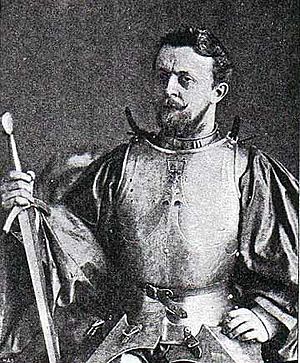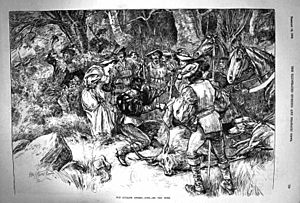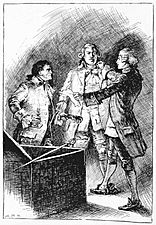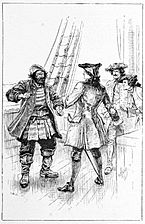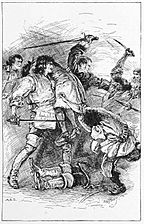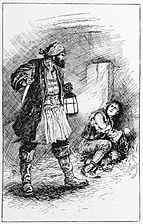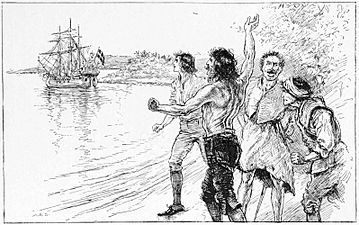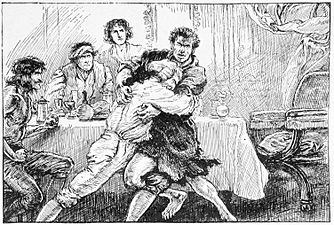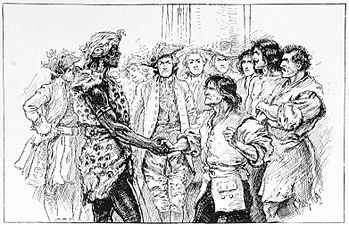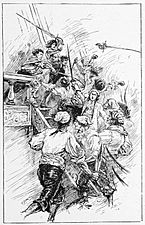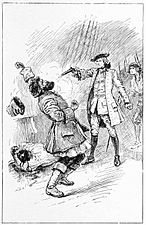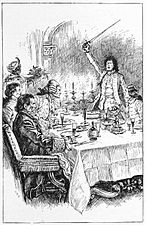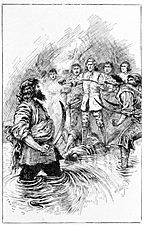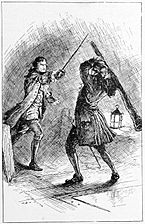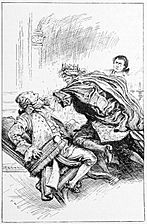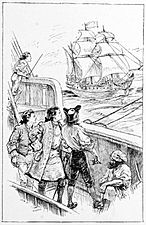Paul Hardy (illustrator) facts for kids
Paul Hardy (full name David Paul Frederick Hardy) was an English artist who drew pictures for books and magazines. He was born near Bath, Somerset on August 2, 1862, and passed away on January 2, 1942, in Storrington.
Paul Hardy was famous for his many drawings in The Strand Magazine. He also painted a well-known picture called Canterbury Pilgrims in 1903. His drawings often went with stories written by Samuel Walkey. Paul came from a family of artists; his father, David Hardy, and his grandfather were also artists. They were from an old family in Yorkshire.
Contents
Early Life and Home
Paul Hardy went to school in Clifton, West Yorkshire. In 1886, he moved to Chelsea, London. He got married in 1888 and then moved back to the countryside, living in a place called The Cottage in Storrington.
Paul was the son of David and Emily Hardy. He married Ida Mary Wilton Clarke Hardy on July 28, 1888. They had a son named Gordon Paul Umfreville Hardy, who was born in 1894.
Paul was also good at working with metal. He even designed and made a weathervane shaped like a ship, which is now kept inside St Mary's church in Storrington.
Paul Hardy's Art and Work
Paul Hardy showed his paintings at the Royal Academy of Arts in London. In 1890, he showed a painting called His Majesty Henry VIII visits Sir Thomas More at Chelsea. He showed another painting in 1899.
Hardy was very skilled at making his own replica armor. He even advised the British Museum's Armoury Department and the auction house Sotheby's about old weapons and armor. Because of his amazing black and white drawings and his knowledge of medieval armor, he received a special pension in 1932. He also received a pension from the Royal Academy a few years later.
Paul Hardy drew pictures for at least 170 books during his career. He also drew a lot for magazines. One popular magazine for young people that he regularly illustrated was Chums. He drew for Chums for over 40 years, from 1896 to 1940.
Authors Paul Hardy Illustrated
Paul Hardy illustrated stories for many different authors. Here are some of the well-known writers whose books featured his drawings:
- Jane Austen (1775–1817), an English novelist famous for books like Pride and Prejudice.
- R. M. Ballantyne (1825–1894), a Scottish author who wrote many adventure stories for young people.
- Charlotte Brontë (1816–1855), a poet and novelist, one of the famous Brontë Sisters.
- Wilkie Collins (1824–1889), an English writer known for mystery novels like The Lady in White and The Moonstone.
- Arthur Conan Doyle (1859–1930), a British writer who created the famous detective Sherlock Holmes.
- Alexandre Dumas (1802–1870), a French writer known for books like The Three Musketeers.
- G. A. Henty (1832–1902), a writer of adventure stories for boys, often set in history.
- Victor Hugo (1802–1885), a French writer famous for Les Misérables and The Hunchback of Notre-Dame.
- W. H. G. Kingston (1814–1880), who wrote adventure books for boys.
- Frederick Marryat (1792–1848), a Royal Navy officer who wrote adventure books for children.
- Walter Scott (1771–1832), a Scottish historical novelist and poet who wrote Ivanhoe.
- Samuel Walkey (1871–1953), a Cornish writer who wrote adventure stories for boys.
Example of Story Illustrations
One of Samuel Walkey's popular stories was Rogues of the Fiery Cross. It appeared in Chums magazine between 1896 and 1897 and was a huge hit! Paul Hardy illustrated this story, just like he did for most of Walkey's other works in Chums. After being in the magazine, Rogues of the Fiery Cross was quickly published as a book in 1897. It included sixteen full-page illustrations by Paul Hardy, which you can see below:
Paul Hardy's Style
Experts say that Paul Hardy was a very active illustrator, especially for adventure stories in magazines. He was known for paying close attention to historical details, like how ships were rigged or what costumes people wore in different time periods. He even had his own collection of old costumes for his models to wear when he drew them!
One expert noted that Paul Hardy was best at drawing "costume romances and adolescent series." Another said that his work was "distinctive and accomplished." His drawings of villains and pirates were very realistic, and he was great at showing the details of old ships. His characters often had wide-open eyes and serious expressions, and they were almost always in action!
The fact that Chums magazine kept using his work for over 40 years shows how much they valued his talent.


